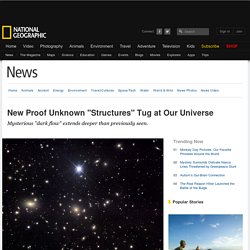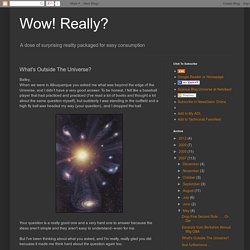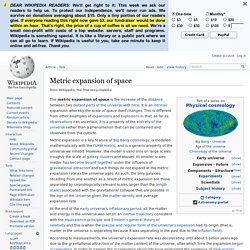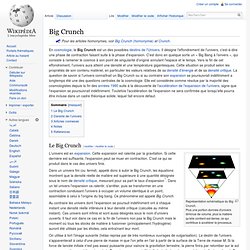

New Proof Unknown "Structures" Tug at Our Universe. "Dark flow" is no fluke, suggests a new study that strengthens the case for unknown, unseen "structures" lurking on the outskirts of creation.

In 2008 scientists reported the discovery of hundreds of galaxy clusters streaming in the same direction at more than 2.2 million miles (3.6 million kilometers) an hour. This mysterious motion can't be explained by current models for distribution of mass in the universe. What is the universe expanding into? What’s outside the universe? Physicist: Probably nothing.

We do know that the universe doesn’t need anything to expand into, and we haven’t seen any evidence that there is anything outside of the universe. But there has still been some speculation. In the last hundred years physics has gotten pretty weird, and defining “universe” has become a little tricky. So, in what follows I’m defining the universe as “all the places that could be connected to one another by a sufficiently long rope” (never mind how the rope got there). Having never been outside of the universe, it’s hard to discuss it with any certainty. We can say that space isn’t “made of anything”, and that it doesn’t need any kind of “higher space” to exist in. In a conversation about spacetime often as not you’ll have some unpleasant and unrepentant jackass drawing parallels to rubber or sheets or something else material. For example, there’s no difference whatsoever between moving and being stationary. Point is: space isn’t stuff. The Universe and Beyond. What lies beyond the universe?

We are not sure but can theorize what lies beyond the universe that we know. Outside the bounds of our univsere may lie a "super" universe. Space outside space that extends infinitely into what our little bubble of a universe may expand into forever. Lying hundreds of billions of light years from us could be other island universes much like our own. But why cant we see them? Another theory is that we are creating space as our universe expands. Yet another is that we are stuck inside a black hole of a larger universe outside our own.
In short, there are many theories about what may be out there. Wow! Really?: What's Outside The Universe? Bailey,When we were in Albuquerque you asked me what was beyond the edge of the Universe, and I didn't have a very good answer.

To be honest, I felt like a baseball player that had practiced and practiced (I've read a lot of books and thought a lot about the same question myself), but suddenly I was standing in the outfield and a high fly ball was headed my way (your question)...and I dropped the ball. Your question is a really good one and a very hard one to answer because the ideas aren't simple and they aren't easy to understand--even for me. But I've been thinking about what you asked, and I'm really, really glad you did becuase it made me think hard about the question again too. Next time we see each other, maybe we can talk about this more, but here's my answer: think about the earth. It's a big ball, and when you look toward the horizon it looks like you can see where the earth stops. But now think of this . . . you're a bug inside a balloon.
But be careful. Grandpa Tom P.S. The observable Universe and beyond. 26 August 2012Last updated at 19:07 ET By Anthony Aguirre Associate Professor of Physics at the University of California.

Metric expansion of space. Metric expansion is a key feature of Big Bang cosmology, is modeled mathematically with the FLRW metric, and is a generic property of the universe we inhabit.

However, the model is valid only on large scales (roughly the scale of galaxy clusters and above). What is the Universe Expanding Into? Come on, admit it, you’ve had this question.

“Since astronomers know that the Universe is expanding, what’s it expanding into? What’s outside of the Universe?” Ask any astronomer and you’ll get an unsatisfying answer. We give you the same unsatisfying answer, but really explain it, so your unsatisfaction doesn’t haunt you any more. What is the universe expanding into? I am very confused about things my science book says about the expanding universe.

Every book I have seen has defined the universe as "everything". If the universe is expanding what is it expanding into? It would have to expand into even more universe. I understand that the red spectra indicates that things are moving away from us but that is drifting not expanding, right? If you could help me to understand this, it would be appreciated. This is a very good question which is not at all easy to give a satisfactory answer to! Now, for those of you who want a more comprehensive discussion: Nobel physics prize honours accelerating Universe find. 4 October 2011Last updated at 11:02 By Jason Palmer Science and technology reporter, BBC News The three researchers' work has led to an expanding knowledge of our Universe Three researchers behind the discovery that our Universe's expansion is accelerating have been awarded this year's Nobel prize for physics.

Saul Perlmutter and Adam Riess of the US and Brian Schmidt of Australia will divide the prize. The trio studied what are called Type 1a supernovae, determining that more distant objects seem to move faster. Their observations suggest that not only is the Universe expanding, its expansion is relentlessly speeding up. Prof Perlmutter of the University of California, Berkeley, has been awarded half the 10m Swedish krona (£940,000) prize, with Prof Schmidt of the Australian National University and Prof Riess of Johns Hopkins University's Space Telescope Science Institute sharing the other half. Quand le cosmos s'organise. The Scale of the Universe. Big Crunch. Un article de Wikipédia, l'encyclopédie libre.

En cosmologie, le Big Crunch est un des possibles destins de l'Univers. Il désigne l'effondrement de l'univers, c'est-à-dire une phase de contraction faisant suite à la phase d'expansion. C'est donc en quelque sorte un « Big Bang à l'envers », qui consiste à ramener le cosmos à son point de singularité d'origine annulant l'espace et le temps. Vers la fin de cet effondrement, l'univers aura atteint une densité et une température gigantesques. Cette situation se produit selon les propriétés de son contenu matériel, en particulier les valeurs relatives de sa densité d'énergie et de sa densité critique.
Le Big Crunch[modifier | modifier le code] Représentation schématique du Big Crunch. L'univers est en expansion. Au contraire les univers dont l'expansion se poursuit indéfiniment ont à chaque instant une densité réelle inférieure à leur densité critique (calculée au même instant). Spitzer mesure l’expansion de l’univers. Chaque seconde, chaque volume d'Univers de trois millions d'années-lumière de côté gagne 74 kilomètres... C'est le résultat d'une mesure récente de la constante de Hubble réalisée avec le satellite infrarouge Spitzer et portant sur dix étoiles céphéides de notre galaxie et plus 80 autres du Grand Nuage de Magellan. La valeur mesurée - 74,3 km/s/Mpc (kilomètres par seconde et par mégaparsec, un parsec valant 3,26 années-lumière) - est proche de celle obtenue en 2011 dans le visible avec le télescope spatial Hubble par la même méthode : 73,8 km/s/Mpc. Chandelles standard Ce n'est pas un hasard si les céphéides ont été utilisées dans ces deux études.
Elles sont de précieux étalons de distance. Autrement dit, mesurer leur rythme revient à mesurer leur luminosité intrinsèque, ce qui permet de déduire leur distance à partir de leur éclat apparent. L'étude du télescope Hubble portait sur 600 céphéides dans des galaxies parfois très lointaines. The Scale of the Universe. Hubble law and the expanding universe. The proportionality between recession velocity and distance in the Hubble Law is called the Hubble constant, or more appropriately the Hubble parameter since it does depend upon time.
In recent years the value of the Hubble parameter has been considerably refined, and the current value given by the WMAP mission is 71 km/s per megaparsec. The recession velocities of distant galaxies are known from the red shift, but the distances are much more uncertain. Distance measurement to nearby galaxies uses Cepheid variables as the main standard candle, but more distant galaxies must be examined to determine the Hubble constant since the direct Cepheid distances are all within the range of the gravitational pull of the local cluster. Big Crunch. L'EXPANSION DE L'UNIVERS EST-ELLE INFINIE ?